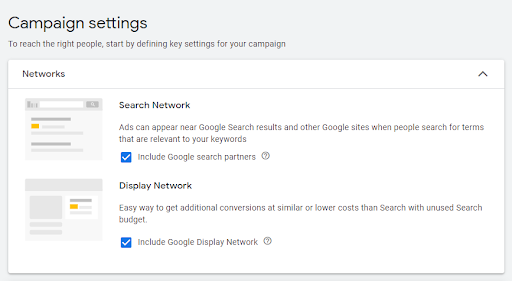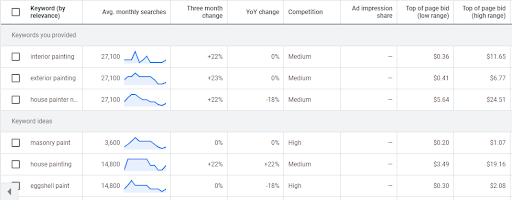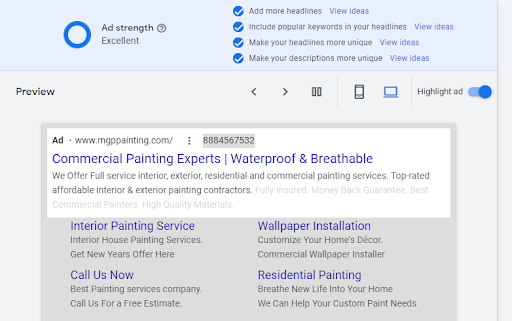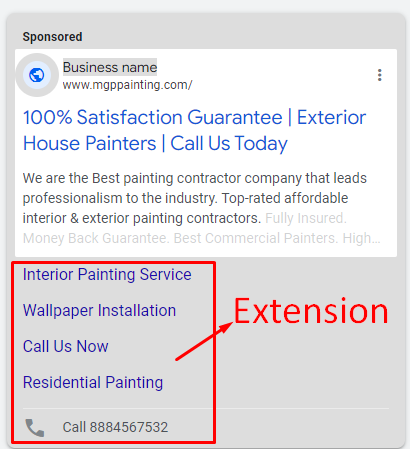- 1. Set a Limit on Your Google Ads Spends
- 2. Build a Great Campaign Structure
- 3. Consider Your Business Objective
- 4. What Keywords Should You Focus on
- 5. Ensure the Optimization of Your Landing Page
- 6. Smart Bidding
- 7. Make Quality Ads
- 8. Implement Extension
- 9. Measure Your Campaign on Weekly Bases
- 10. Use Google’s Remarketing Feature
Running a successful Google Ads campaign can be a great way to drive traffic to your website and increase your business’s revenue. There are many ways to advertise your small businesses when you’re the owner. However, many small businesses face the challenge of limited budgets when it comes to advertising.
For every dollar spent on Google AdWords, advertisers typically make $8, according to Google. The good news is that with some strategic planning and execution, it is possible to run an effective Google Ads campaign even if you have a limited budget.
In this blog, we will share 10 Tips for Running Effective Google Ads campaign with a tight budget:
1. Set a Limit on Your Google Ads Spends
When a small business owner takes a step to advertise their small business on google. The first question which comes to their mind is how much budget should they spend so that they can boost their business.
So for a small business, the first step should be to tell the owner that they should set a maximum amount they’re comfortable spending each month, and from there you can start figuring out whether or not this number is going to work.
Google Ads allows advertisers to set a daily budget for their campaigns, which is the maximum amount they are willing to spend per day. The minimum daily budget is $1.
Before setting up a limit on your google ads spending Two factors might change what you’re willing to spend each month:
Analyses your market research
Analyses your market and figures out what your competitors are spending, and how or what a typical bid is for keywords in your industry.
Choose what You Consider a conversion
In the era of online marketing, conversion is king. It’s the moment when a website visitor takes a desired action, such as making a purchase or filling out a form and more. But what exactly Consider a conversion can vary depending on the goals of a business or website.
First, let’s talk about why it’s important to define what a conversion should be for a small business. If you don’t have a clear idea of what you’re trying to achieve, it’s impossible to measure your progress and make informed decisions about how to improve.
For example, if you’re running an e-commerce store, you might consider a conversion to be a completed purchase. But if you’re a B2B company, a conversion might be someone filling out a contact form or requesting a quote. By defining your conversion, you can better understand how effective your website and marketing efforts are at driving that desired action.
2. Build a Great Campaign Structure
Building a great campaign structure is crucial to achieving success in your advertising campaign. It can help you optimize your budget, reach your target audience, and ultimately achieve your marketing goals.

building a great campaign structure requires careful planning and attention to detail. By defining your goals, identifying your target audience, creating ad groups, choosing the right keywords, writing compelling ad copy, setting bids and budgets, and monitoring performance, you can create effective advertising campaigns that deliver results.
3. Consider Your Business Objective
Before starting your ad campaign, you need to have a clear understanding of what you want to achieve. Whether it is increasing website traffic, generating leads, or increasing sales, define your goals and prioritize them according to their importance. This will help you focus your ad spend on the most critical objectives.
One of the main reasons that agencies insist on minimum spending is that the fact is quicker you pay for your services and the quicker you’ll receive important data. The faster your ability to implement improvements to your advertising campaigns, the quicker Google will train its machine learning to find your top prospects and present them with the advertisements, and the quicker you’ll be able to start creating leads.
A higher budget can also allow the user to experiment with various campaigns and compare ads, place bids for more competitive keywords and target larger geographical areas, and much more.
In order for your budget to expand, you’ll need to limit your business’s goals likely to one goal in the beginning. This will limit the chances of being identified for every one of the activities you perform but you’ll be able to avoid burning over your funds without acquiring crucial information.
Once you’ve established the upper limits of your budget and have identified your objective. now It’s time to focus on your keywords.
4. What Keywords Should You Focus on
Keywords are an essential component of any digital marketing strategy, as they can drive traffic to your website and help you reach your target audience. However, not all keywords are created equal when it comes to generating conversions.
Although a lot of research can provide an idea of the amount you’ll be spending or the keywords that are most effective, you must collect enough information about your campaigns in order to maximize your bidding, targeting, and spending. Similar to business goals If you are spreading your budget too thinly across several keywords you’ll never have sufficient data to make informed decisions.
Before adding keywords to google ads first we have to do PPC keyword research for that we have to know which types of keywords should you use. There are several types of keywords that can be used in PPC campaigns. Here are some of the most common types:
Short-tail keywords
Also known as “head keywords”, these are short and general phrases that typically contain one or two words. They have a high search volume but are often highly competitive, making it difficult to rank them. For Example “shoes”, “food”, and “travel”.
Long-tail keywords
These are longer and more specific phrases that usually contain three or more words. They have lower search volume but are less competitive and often have higher conversion rates.
For Example “best running shoes for women”, “best digital marketing company in USA”, and “affordable travel destinations in Europe”.
Branded keywords
Branded keywords are search terms that include a specific brand name, product name, or any other unique identifier associated with a business. These keywords are used by consumers when searching for a specific brand or product online. For example, “Nike shoes” or “Coca-Cola soft drinks” are examples of branded keywords.
Google’s Keyword Planner for keywords research
Google’s Keyword Planner is a free tool that helps users research keywords for their online advertising campaigns. It’s a part of Google Ads, a pay-per-click (PPC) advertising platform, and can be accessed by creating a Google Ads account.

Using Keyword Planner, users can search for keywords related to their business or industry, and get information about their search volume, competition, and estimated cost-per-click (CPC) for advertising. The tool provides various options to refine the keyword research, such as filtering by location, language, and device.

Keyword Planner also allows users to enter their website or landing page and generate keyword ideas based on the content of their website. This feature can be helpful in discovering keywords that may be relevant to their business but may not have been considered before.
Overall, Google’s Keyword Planner is a powerful tool for keyword research and can help businesses improve their online advertising efforts by finding relevant and high-performing keywords.
5. Ensure the Optimization of Your Landing Page
Pay-per-click (PPC) advertising can be an effective way to drive traffic to your website and generate leads. However, if your landing page is not optimized for conversions, you may be wasting your advertising budget.
If someone clicks on the ad and ends up on a landing page that is irrelevant or confusing, they are likely to bounce back to the search results page and try a different link. This not only results in a lost opportunity for you to convert that person into a customer, but it can also negatively impact your Quality Score, which affects your ad position and cost-per-click.
That’s why it’s so important to ensure that your landing page is optimized for conversions. By creating a landing page that is relevant, easy to navigate, and provides clear and concise information, you increase the likelihood that visitors will take the desired action, whether that’s making a purchase, filling out a form, or downloading a resource.
6. Smart Bidding
One of the key factors that determine the success of a PPC campaign is the bidding strategy used to bid for ad placements. Smart Bidding is an automated bidding strategy that uses machine learning to optimize bids for conversions or conversion value.

It uses historical performance data and real-time user data to adjust bids, making the bidding process more efficient and effective. Smart Bidding can be used for different campaign types, including search, display, shopping, and video.
Smart Bidding is an automated bidding strategy that uses machine learning to adjust bids based on various signals such as user intent, device type, location, and time of day. Smart Bidding can adjust bids in real-time, up to 70 times per second, based on user behavior and data signals.
According to Google, advertisers who use Smart Bidding see an average increase of 30% in conversions while decreasing their cost per acquisition (CPA) by 20%.
7. Make Quality Ads
When it comes to advertising on Google, Creating high-quality ads is essential to attracting the right audience and driving conversions. Google Ads is a powerful tool that allows advertisers to reach a vast and diverse audience. it’s crucial to create ads that stand out and resonate with your target audience.

When you create an ad on Google Ads, Google assigns you a Quality Score out of 10. This score is based on a number of factors, including the relevance of your ad to the search query, the quality of your landing page, and the expected click-through rate of your ad.
A high-Quality Score means that Google considers your ad to be relevant and useful to its users, which can result in a higher ad ranking and lower costs per click.
On the other hand, a low-Quality Score can mean that your ad is less likely to be shown to potential customers, and you may end up paying more for clicks.
Hence Google values high-quality and relevant content, which is reflected in the Quality Score assigned to your ad. By focusing on key elements, you can improve your ad ranking, drive conversions, and achieve your advertising goals.
8. Implement Extension
Implementing extensions in your Google Ads is a crucial step in making your ads more effective and relevant to potential customers. By adding additional information and options to your ads, you can increase their visibility, improve click-through rates, and enhance relevance.

Google offers a variety of extensions, including call extensions, location extensions, sitelink extensions, and more.These can all be modified to suit the particular requirements of your company. Google ads extension it’s important to consider your audience and their needs, as well as the goals of your advertising campaign.
9. Measure Your Campaign on Weekly Bases
Measuring the performance of your Google Ads campaign is essential for ensuring that your advertising budget is being used effectively and efficiently. For running effective google ads it is important that you should measure your campaign on weekly bases.
By tracking metrics such as click-through rate, conversion rate, and cost per click, you can gain insights into how your ads are performing and make data-driven decisions to optimize your campaigns.
Remember to keep in mind the industry benchmarks for each metric, but also consider the unique goals and audience of your business when analyzing your results. With a focus on continuous improvement and data-driven decision-making, you can create effective Google Ads campaigns that drive conversions and meet your business goals.
10. Use Google’s Remarketing Feature
Google’s remarketing is a powerful feature that enables businesses to reach out to previous website visitors who did not convert. By utilizing this feature, businesses can display targeted ads to these individuals across the Google Display Network, giving them a second chance to convert.
According to Google, remarketing campaigns have a click-through rate (CTR) that is ten times higher than regular display ad campaigns.
Additionally, businesses that use remarketing have reported an average increase in conversion rates of 51%. With such impressive statistics, it is clear that Google’s remarketing feature is a valuable tool for businesses looking to boost their online sales and conversions.
Conclusion
In conclusion, running effective Google Ads on a tight budget is possible with the right strategies and approaches. By implementing the ten tips discussed in this Blog, advertisers can achieve their marketing objectives.
Advertisers should prioritize audience targeting, keyword research, ad copy optimization, and campaign monitoring to ensure their ads are reaching the right audience and generating conversions.
By continuously testing and refining their ad campaigns, advertisers can improve their return on investment and stretch their budget further. With a combination of strategic planning and consistent optimization, even advertisers with limited budgets can drive significant results through Google Ads.

